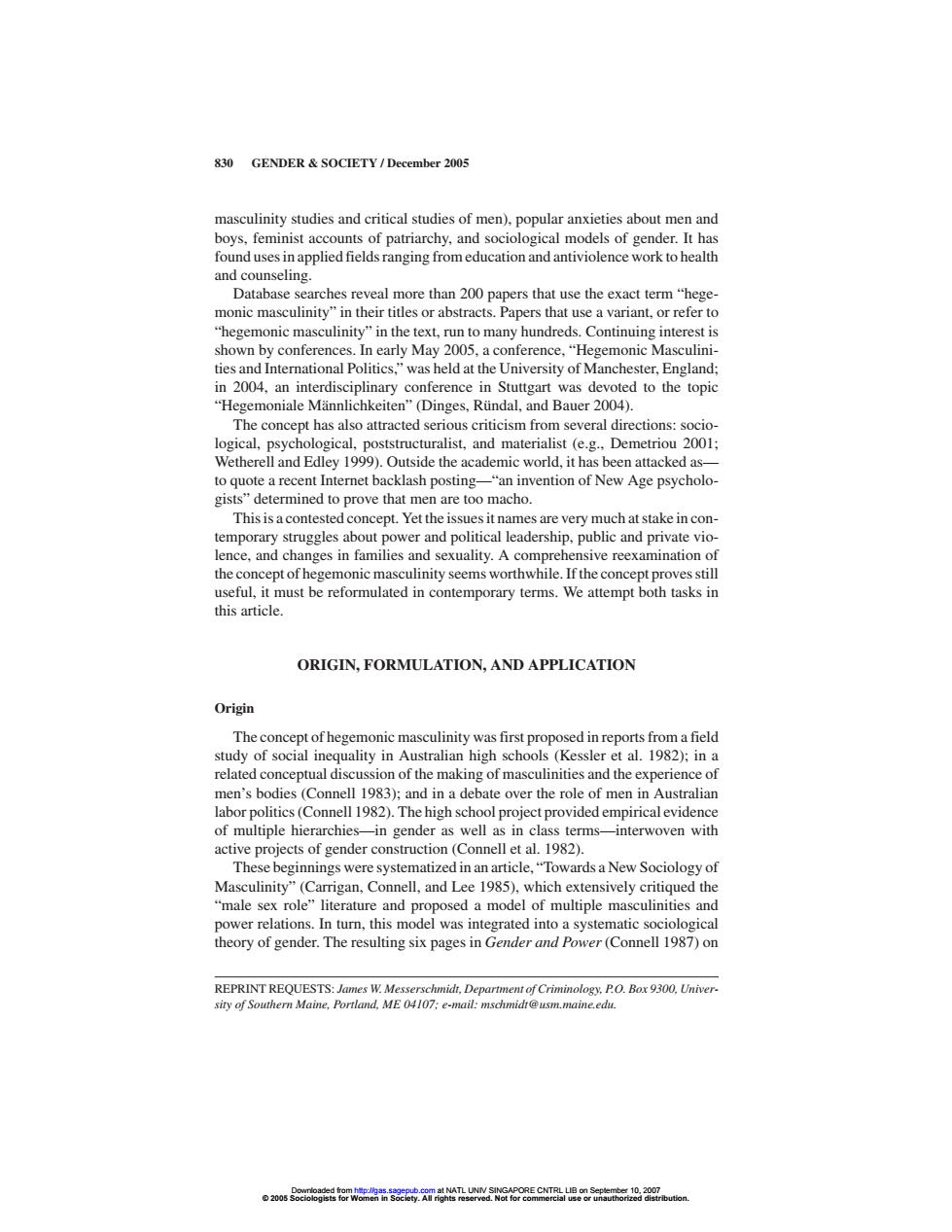正在加载图片...

830 GENDER SOCIETY/December 2005 masculinity studies and critical studies of men),popular anxieties about men and boys,feminist accounts of patriarchy,and sociological models of gender.It has found uses in applied fields ranging from education and antiviolence work to health and counseling. Database searches reveal more than 200 papers that use the exact term"hege- monic masculinity"in their titles or abstracts.Papers that use a variant,or refer to "hegemonic masculinity"in the text,run to many hundreds.Continuing interest is shown by conferences.In early May 2005,a conference,"Hegemonic Masculini- ties and International Politics,was held at the University of Manchester,England; in 2004,an interdisciplinary conference in Stuttgart was devoted to the topic "Hegemoniale Mannlichkeiten"(Dinges,Ruindal,and Bauer 2004). The concept has also attracted serious criticism from several directions:socio- logical,psychological,poststructuralist,and materialist (e.g.,Demetriou 2001; Wetherell and Edley 1999).Outside the academic world,it has been attacked as- to quote a recent Internet backlash posting-"an invention of New Age psycholo- gists"determined to prove that men are too macho. This is a contested concept.Yet the issues it names are very much at stake in con- temporary struggles about power and political leadership,public and private vio- lence,and changes in families and sexuality.A comprehensive reexamination of the concept of hegemonic masculinity seems worthwhile.If the concept proves still useful,it must be reformulated in contemporary terms.We attempt both tasks in this article. ORIGIN,FORMULATION,AND APPLICATION Origin The concept of hegemonic masculinity was first proposed in reports from a field study of social inequality in Australian high schools (Kessler et al.1982):in a related conceptual discussion of the making of masculinities and the experience of men's bodies (Connell 1983);and in a debate over the role of men in Australian labor politics(Connell 1982).The high school project provided empirical evidence of multiple hierarchies-in gender as well as in class terms-interwoven with active projects of gender construction (Connell et al.1982). These beginnings were systematized in an article,"Towards a New Sociology of Masculinity"(Carrigan,Connell,and Lee 1985),which extensively critiqued the "male sex role"literature and proposed a model of multiple masculinities and power relations.In turn,this model was integrated into a systematic sociological theory of gender.The resulting six pages in Gender and Power (Connell 1987)on REPRINT REQUESTS:James W.Messerschmidt,Department of Criminology,P.O.Box 9300.Univer- sity of Southern Maine,Portland,ME 04107;e-mail:mschmidt@usm.maine.edu. o2oosS6e08a8rmh8Pg532RT4T6066O2ECTBgarto1827butionmasculinity studies and critical studies of men), popular anxieties about men and boys, feminist accounts of patriarchy, and sociological models of gender. It has found uses in applied fields ranging from education and antiviolence work to health and counseling. Database searches reveal more than 200 papers that use the exact term “hegemonic masculinity” in their titles or abstracts. Papers that use a variant, or refer to “hegemonic masculinity” in the text, run to many hundreds. Continuing interest is shown by conferences. In early May 2005, a conference, “Hegemonic Masculinities and International Politics,” was held at the University of Manchester, England; in 2004, an interdisciplinary conference in Stuttgart was devoted to the topic “Hegemoniale Männlichkeiten” (Dinges, Ründal, and Bauer 2004). The concept has also attracted serious criticism from several directions: sociological, psychological, poststructuralist, and materialist (e.g., Demetriou 2001; Wetherell and Edley 1999). Outside the academic world, it has been attacked as— to quote a recent Internet backlash posting—“an invention of New Age psychologists” determined to prove that men are too macho. This is a contested concept. Yet the issues it names are very much at stake in contemporary struggles about power and political leadership, public and private violence, and changes in families and sexuality. A comprehensive reexamination of the concept of hegemonic masculinity seems worthwhile. If the concept proves still useful, it must be reformulated in contemporary terms. We attempt both tasks in this article. ORIGIN, FORMULATION, AND APPLICATION Origin The concept of hegemonic masculinity was first proposed in reports from a field study of social inequality in Australian high schools (Kessler et al. 1982); in a related conceptual discussion of the making of masculinities and the experience of men’s bodies (Connell 1983); and in a debate over the role of men in Australian labor politics (Connell 1982). The high school project provided empirical evidence of multiple hierarchies—in gender as well as in class terms—interwoven with active projects of gender construction (Connell et al. 1982). These beginnings were systematized in an article, “Towards a New Sociology of Masculinity” (Carrigan, Connell, and Lee 1985), which extensively critiqued the “male sex role” literature and proposed a model of multiple masculinities and power relations. In turn, this model was integrated into a systematic sociological theory of gender. The resulting six pages in Gender and Power (Connell 1987) on 830 GENDER & SOCIETY / December 2005 REPRINT REQUESTS: James W. Messerschmidt, Department of Criminology, P.O. Box 9300, University of Southern Maine, Portland, ME 04107; e-mail: mschmidt@usm.maine.edu. © 2005 Sociologists for Women in Society. All rights reserved. Not for commercial use or unauthorized distribution. Downloaded from http://gas.sagepub.com at NATL UNIV SINGAPORE CNTRL LIB on September 10, 2007